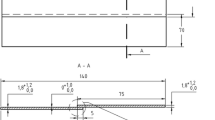Abstract
Laser-arc hybrid welding is known for its superior joint strength relative to arc welding and its ability to fill the gap that laser welding cannot otherwise fill. The role of laser-arc interaction in filling the lap-fillet joint is the point of investigation in this article. The effect of the laser and arcing parameters on the weld's formation is tested experimentally with the variable gap between the plates. The arc and laser parameters play a significant role in bridging the gap. For example, appropriate process parameters, such as low welding speed and moderate to high welding current, can bridge the gap up to 1 mm. Sufficient laser power is essential to improve the gap bridgeability. A low power laser preheats the base plate that helps spread the molten material at the cost of filling the gap. An increase in laser power increases the throat thickness and improves the gap bridgeability in a lap-fillet joint. In one way, the lower leg length is the manifestation of increased throat thickness due to the material passing by the gap. In one of the first of its type, the investigation explains the ability to close the gap based on process parameters. The mechanism of the gap bridgeability is deduced based on the material flow in the lap-fillet weld pool.













Similar content being viewed by others
Data Availability
All data generated or analysed during this study are included in this published article.
References
Gao, M., Zeng, X.Y., Hu, Q.W., Yan, J.: Weld microstructure and shape of laser–arc hybrid welding. Sci. Technol. Weld. Joining 13(2), 106–113 (2008)
Meng, W., Li, Z., Lu, F., Wu, Y., Chen, J., Katayama, S.: Porosity formation mechanism and its prevention in laser lap welding for T-joints. J. Mater. Process. Technol. 214(8), 1658–1664 (2014)
Fellman, A.: The effects of some variables on CO2 laser-MAG hybrid welding. Lappeenranta University of Technology (2008)
Allen, C.M., Hilton, P.A., Blackburn, J.: Increasing the tolerance to fit-up gap using hybrid laser-arc welding and adaptive control of welding parameters. In Proceedings of the 37th International MATADOR Conference, Manchester, England (2012)
Lamas, J., Frostevarg, J., Kaplan, A.F.: Gap bridging for two modes of laser-arc hybrid welding. J. Mater. Process. Technol. 224, 73–79 (2015)
Wang, J.B., Nishimura, H., Fujii, K., Katayama, S., Mizutani, M.: Study of improvement of gap tolerance in laser MIG arc hybrid welding of aluminium alloy. Weld. Int. 23(10), 723–733 (2009)
Üstündağ, Ö., Fritzsche, A., Avilov, V., Gumenyuk, A., Rethmeier, M.: Study of gap and misalignment tolerances at hybrid laser-arc welding of thick-walled steel with electromagnetic weld pool support system. Procedia Cirp 74, 757–760 (2018)
Yamamoto, M., Shinozaki, K., Kadoi, K., Fujita, D., Inoue, T., Fukahori, M., Kitahara, Y.: Development of hot-wire laser welding method for lap joint of steel sheet with wide gap. Q. J. Jpn. Weld. Soc. 29(3), 58s–61s (2011)
Ishak, M., Yamasaki, K., Maekawa, K.: Lap fillet welding of thin sheet AZ31 magnesium alloy with pulsed Nd: YAG laser. J. Solid Mech. Mater. Eng. 3(9), 1045–1056 (2009)
Alshaer, A.W., Li, L., Mistry, A.: Understanding the effect of heat input and sheet gap on porosity formation in fillet edge and flange couch laser welding of AC-170PX aluminum alloy for automotive component manufacture. J. Manuf. Sci. Eng. 137(2) (2015)
Möller, F., Kügler, H., Kötschau, S., Geier, A., Goecke, S.F.: Gap bridging ability in laser GMA hybrid welding of thin 22MnB5 sheets. Phys. Procedia 56, 620–629 (2014)
Gao, X.S., Wu, C.S., Goecke, S.F., Kuegler, H.: Effects of process parameters on weld bead defects in oscillating laser-GMA hybrid welding of lap joints. Int. J. Adv. Manuf. Technol. 93(5–8), 1877–1892 (2017)
Hanji, T., Tateishi, K., Shimizu, M., Uchida, D., Asano, K., Kimura, R.: Fatigue strength of cruciform joints and longitudinal joints with laser-arc hybrid welding. Weld. World 63(5), 1379–1390 (2019)
Kochar, P., Sharma, A., Suga, T., Tanaka, M.: Prediction and control of asymmetric bead shape in laser-arc hybrid fillet-lap joints in sheet metal welds. Lasers Manuf. Mater. Process. 6(1), 67–84 (2019)
Shen, F., Zhao, B., Li, L., Chua, C.K., Zhou, K.: Fatigue damage evolution and lifetime prediction of welded joints with the consideration of residual stresses and porosity. Int. J. Fatigue 103, 272–279 (2017)
Mastanaiah, P., Sharma, A., Reddy, G.M.: Process parameters-weld bead geometry interactions and their influence on mechanical properties: A case of dissimilar aluminium alloy electron beam welds. Def. Technol. 14(2), 137–150 (2018)
Liu, S., Mi, G., Yan, F., Wang, C., Jiang, P.: Correlation of high power laser welding parameters with real weld geometry and microstructure. Opt. Laser Technol. 94, 59–67 (2017)
Sharma, A., Verma, D.K., Arora, N.: A scheme of comprehensive assessment of weld bead geometry. Int. J. Adv. Manuf. Technol. 82(9–12), 1507–1515 (2016)
Choudhury, S., Sharma, A., Mohanty, U.K., Kasai, R., Komura, M., Tanaka, M., Suga, T.: Mathematical model of complex weld penetration profile: A case of square AC waveform arc welding. J. Manuf. Process. 30, 483–491 (2017)
Mohanty, U.K., Sharma, A., Nakatani, M., Kitagawa, A., Tanaka, M., Suga, T.: A semi-analytical nonlinear regression approach for weld profile prediction: a case of alternating current square waveform submerged arc welding of heat resistant steel. J. Manuf. Sci. Eng. 140(11) (2018)
Gao, X.S., Wu, C.S., Goecke, S.F., Kügler, H.: Numerical simulation of temperature field, fluid flow and weld bead formation in oscillating single mode laser-GMA hybrid welding. J. Mater. Process. Technol. 242, 147–159 (2017)
Acknowledgements
This investigation is carried out through collaboration between JWRI, Osaka University (within the JIJReC Program 1 April 2019 and 31 March 2020) and KU Leuven (within Startfinanciering project: Heat sources’ interaction in hybrid laser welding (3E200078)).
Author information
Authors and Affiliations
Corresponding author
Ethics declarations
Conflict of Interests
The authors declare that there is no conflict of interest.
Additional information
Publisher’s Note
Springer Nature remains neutral with regard to jurisdictional claims in published maps and institutional affiliations.
Rights and permissions
About this article
Cite this article
Sharma, A., Mohanty, U.K., Tanaka, M. et al. Mechanism of Gap Bridgeability in Lap-Fillet Laser-Arc Hybrid Welding. Lasers Manuf. Mater. Process. 8, 355–371 (2021). https://doi.org/10.1007/s40516-021-00150-6
Accepted:
Published:
Issue Date:
DOI: https://doi.org/10.1007/s40516-021-00150-6



